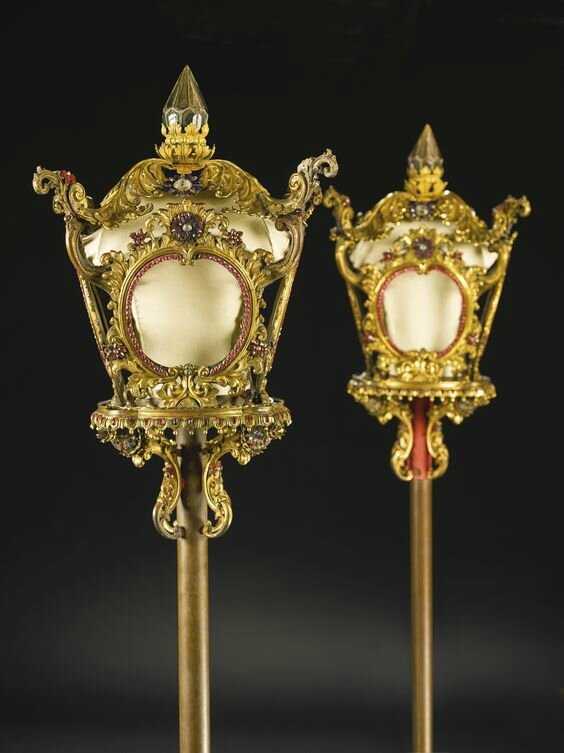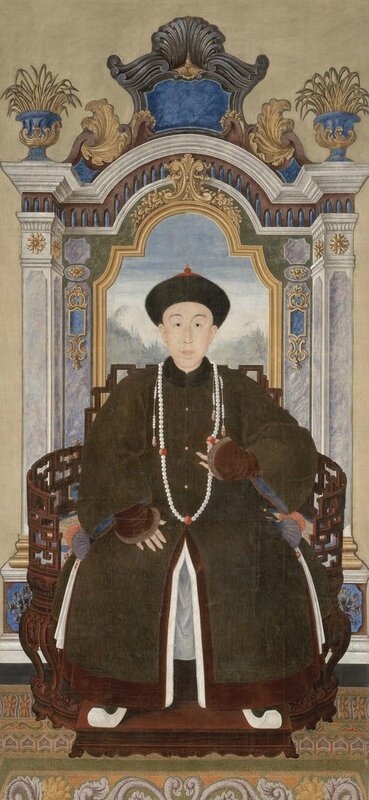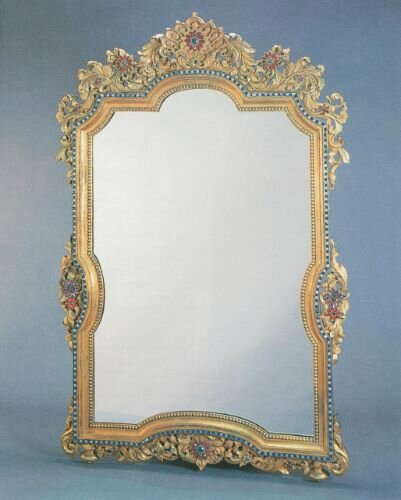An extremely rare pair of gilt-bronze and paste-set lanterns, Qing dynasty, Qianlong period
Lot 115. An extremely rare pair of gilt-bronze and paste-set lanterns, Qing dynasty, Qianlong period. Estimate 500,000 — 800,000 USD. Photo: Sotheby's.
each lantern composed of four oval frames, each bordered by a narrow red paste-inset band and ornate foliate scrolls centered above by a leafy crest set with a paste-set flowerhead and applied with further paste-set florets, each divided by foliate brackets supporting a hinged cover composed of four feathery acanthus leaves surmounted by a finial of faceted form composed of mirrored glass panels, supported on a lotus lappet-edged shaped base fixed to a later-replacement pole by foliate brackets terminating in mulit-colored paste-set pineapple finials, the pole set into an elaborate base cast in the form of four adorsed dolphins amidst turbulent waves, enclosed by a galleried rim atop a foot cast with peony, lotus lappets, further acanthus leaves and scrolling foliage (2). Height 69 3/4 in., 177 cm
Provenance: Edward I. Farmer, New York.
Notes: These remarkable lanterns represent the height of intellectual, cultural and material exchange during the Qing dynasty. Elaborate designs that merged European and Chinese forms and decorative motifs were intentionally chosen by the Qianlong Emperor in his desire to display imperial supremacy and grandeur. He commissioned Chinese and Western artisans to work together to create highly decorative pieces that were often unique. These lanterns appear to be an example of such unique products as no other related example appears to have been published, although elements of the design can be found on various works of art.
While the imitation of Chinese styles, known as ‘chinoiserie’ was popular at the courts in Europe during the 18th century, there was also a vogue at the Chinese court for fine works in European style. During the mid-18th century European Jesuit artists were employed at the court to design the palaces in the northern part of the Yuanming Yuan, also known as the Old Summer Palace. The resulting buildings combined a mix of Italian rococo, French rocaille and Chinese or Mughal-inspired foliate and floral designs. These lanterns were probably produced during the height of the Chinese court’s fascination with the European styles, as exemplified by the very similar motifs found on the architectural members of the European palaces. The emperor then commissioned craftsmen to fill the grand halls with equally opulent and European-style works of art, porcelains and décor. A portrait of the half brother of the Qianlong emperor, Hongyan, Prince Guo (1733-1765) (fig.1) in the collection of the Freer Sackler Museum, Washington D.C., shows the prince seated before an ornate European architectural backdrop, thought to refer to the Yuanming Yuan.
Fig.1. Portrait of Hongyan, Prince Guo (1733-1765), Qing dynasty, Qianlong period. Arthur M. Sackler Gallery, Smithsonian Institution, Washington, D.C.: Purchase- Smithsonian Collections Acquisition Program and partial gift of Richard G. Pritzlaff, S1991.47.
Although at first glance these lanterns appear highly Western, closer inspection reveals elements of Chinese decoration, materials and craftsmanship. While the tapering rectangular form and foliate design are reminiscent of elaborate Italian and French lamps, the style and combination of gilt and red set-paste inlay are typically Chinese. The circular shape on each side is formed by a highly stylised ruyi head while the petal band encircling the base of the lantern bears close resemblance to those found on gilt-bronze Buddhist figures. The curling fronds, which appear to combine Mughal foliate designs with European scrolls, would have provided aesthetic pleasure not only when viewed in daylight but also when lit at night through the wonderfully enigmatic shadows that would have been cast across the room.
Components of these sumptuous lanterns are found on imperial works of art; for example the style of the curling leaves framing an oval shape bear resemblance to a clock from the Palace Museum, Beijing, included in the exhibition Tributes from Guangdong to the Qing Court, Chinese University of Hong Kong, Hong Kong, 1987, cat. no. 83, along with a large mirror surmounted by a clock, cat. no. 80. Compare also three mirrors, similarly cast and inlaid, from the collection of Hermann von Mandl acquired in China and believed to have come from the Summer Palace, Beijing, sold in our Hong Kong rooms, two, 17th May 1989, lots 439 and 440, and the third, 15th November 1989, lot 572 (fig. 2). The pineapples suspended from the base of the lantern, which to the West represented exotic items of curiosity of the ‘new world’ yet which had been grown in China since the Ming dynasty, were also employed as finials; for example see a clock from the Qing Court collection, and still in Beijing, illustrated in The Complete Collection of Treasures of the Palace Museum. Scientific and Technical Instruments of the Qing Dynasty, Hong Kong, 1998, pl. 218, together with a possible English inspiration, pl. 185; and a painted enamel stemcup, included in the exhibition Emperor Ch’ien-lung’s Grand Cultural Enterprise, National Palace Museum, Taipei, 2002, cat. no. IV-17.
Fig.2. A gilt-bronze and paste-set mirror, Qing dynasty, Qianlong period. Sotheby’s Hong Kong, 15th November 1989, lot 572.
Tall lampstands made of precious hardwood, such as zitan and huanghuali, became popular in the Ming and early-Qing dynasties. Known as zhutai in the Ming architectural treatise Lu Ban jing, and dengtai by modern craftsmen, these lanterns appear to have been supported on three main base types: three-legged, adjustable table screen-form, and cross-shaped, which forms the base of the present stand. The four fish that form the base are likely to derive from French ormolu dolphin supports and comparable stone carvings can be found in the ruins of a fountain in the Yuanming Yuan, as pictured in situ, and now in Peking University, Beijing, illustrated in Yuanmingyuan liusan wenwu, Beijing, 2007, p. 19.
Extravagant lanterns were traditionally created for festival days, particularly for the Lantern Festival (Dengjie), which took place around the fifteenth of the first month and was the climax of the Chinese New Year celebrations. In China, lamps have not only aesthetic and practical functions, but spiritual ones as well, and were thus an integral part of rituals. According to Sarah Handler, ‘Carriers of Light: The Chinese Lampstand and Lantern’, Classical Chinese Furniture Society, Spring 1991, p. 19, ‘firelight, with its ultimate source in the sun, has in all cultures been associated with divinity, knowledge, and enlightenment, whether of the sun or of emperors, as well as the human spirit or soul’.
Sotheby's. Chinese Art from Caramoor Center for Music and the Arts, New York, 15 mars 2016, 02:00 PM

/https%3A%2F%2Fprofilepics.canalblog.com%2Fprofilepics%2F1%2F0%2F100183.jpg)
/https%3A%2F%2Fstorage.canalblog.com%2F03%2F02%2F119589%2F96711876_o.jpg)
/https%3A%2F%2Fstorage.canalblog.com%2F11%2F31%2F119589%2F94773502_o.jpg)
/https%3A%2F%2Fstorage.canalblog.com%2F20%2F83%2F119589%2F94772815_o.jpg)
/https%3A%2F%2Fstorage.canalblog.com%2F26%2F72%2F119589%2F75604929_o.jpg)
/https%3A%2F%2Fstorage.canalblog.com%2F59%2F60%2F119589%2F26458628_o.jpg)








/http%3A%2F%2Fstorage.canalblog.com%2F98%2F98%2F119589%2F129097971_o.jpg)
/http%3A%2F%2Fstorage.canalblog.com%2F93%2F75%2F119589%2F128489120_o.jpg)
/http%3A%2F%2Fstorage.canalblog.com%2F09%2F29%2F119589%2F128488304_o.jpg)
/http%3A%2F%2Fstorage.canalblog.com%2F62%2F18%2F119589%2F128488091_o.jpg)